Michael Sgan-Cohen
Michael Sgan-Cohen (2 March 1944 – 20 February 1999) was an Israeli artist, art historian, curator and critic. His oeuvre touches different realms of the Israeli experience and the Hebrew language, displaying a strong connection to the Jewish Scriptures. His works was nurtured by his extensive knowledge of Art history, philosophy, Biblical Texts, Jewish thought and Mysticism, which in turn illuminated all these pursuits. His engagement with Judaism and the Bible as a secular scholar and his vast knowledge of modern and contemporary art contributed to the development of a distinctive approach which combined Jewish and Israeli symbols and images to create a multilayered and contemporary artistic language.
Sgan-Cohen's art was anticipatory in many respects: his concept of Israeli identity as part of Jewish Identity developed long before other artists began to see things in these terms. This reflected in his profound involvement with the formative Jewish sacred texts, both intellectually and by embedding Jewish thought into the essence of his artistic practice. He was one of the pioneers in the sophisticated use of the Hebrew language as a means of expression in contemporary art.
| Michael Sgan-Cohen | |
|---|---|
 | |
| Born |
Michael Sgan-Cohen 2 March 1944 Jerusalem, Israel |
| Died |
20 February 1999 (aged 54) Jerusalem, Israel |
| Nationality | Israeli |
| Education | Hebrew University of Jerusalem, University of California, Los Angeles (UCLA), City University of New York (CUNY) |
| Known for | Painting, Concept |
| Notable work | Moses (1977–1978) Hineni (1978) Coat of Many Colors (1981) Leviathan (1983) The Wandering Jew (1983) |
| Movement | Israeli art, conceptual art |
| Awards |
|
Life
Michael Sgan-Cohen was born in Jerusalem in 1944.[1] His father, Dr. Meir Sgan-Cohen, was a well-known figure in Jerusalem and president Yitzhak Ben-Zvi's personal physician. Sgan-Cohen graduated in Art History and Philosophy from the Hebrew University of Jerusalem in 1969. In the late sixties, while still a student, Sgan-Cohen began writing short articles on art for the literary and cultural supplement of the daily newspaper Haaretz (edited by Benjamin Tammuz).
Between 1969 and 1978 Sgan-Cohen lived in Los Angeles and New York state. In 1973 he earned his M.A degree in art history from the University of California (UCLA) in Los Angeles. Sgan-Cohen moved to New York in late 1973 to study with the art historian and critic Leo Steinberg. During this period, he was associated with the "New York Group" of Israeli artists including Pinchas Cohen-Gan, Benny Efrat, Michael Gitlin and Buky Swchartz. In 1976 he began to work as an artist. In 1978 Sgan-Cohen had his first solo exhibition at the Kibbutz Gallery in Tel Aviv. During his years in New York, Sgan-Cohen taught art history at the Brooklyn College and at the School of Visual Arts. He wrote for a number of art journals, such as Art in America, Art Forum and Art press, as well as for hebrew journals like Mussag, Proza, Kav, Studio and Monitin. He wrote the catalogue articles for Motti Mizrahi (1988) and Ya'akov Dorchin (1990) for The Venice Biennale curated by Adam Baruch. In 1989 Sgan-Cohen earned his PhD from the City University of New-York (CUNY). His dissertation dealt with the artist and architect Frederick Kiessler, who designed the Shrine of the Book in the Israel Museum.
Between 1977 and 1978 Sgan-Cohen returned to Israel and taught at Bezalel Academy of Arts and Design in Jerusalem as well as at the University of Haifa. In 1987 he permanently settled in Jerusalem and since 1990 served as a lecturer in several Art Institutes in Israel including Oranim Academic College in Kiryat Tivon (1990–98), Kalisher Art Academy in Tel Aviv (1990–98), The School of Visual Theatre in Jerusalem (1991–94) and Bezalel Academy of Arts and Design in Jerusalem (1992–98)
In 1993 Sgan-Cohen had a solo exhibition at the library of foyer of the Tel Aviv Museum of Art. In 1994 he had an extensive solo exhibition at the Ramat Gan Museum of Israeli Art. The following years he had two joint exhibitions – in 1995 with Haim Maor at the Museum of Jewish Art in Bar'am and in 1996 with Tsibi Geva at Julie M. Gallery in Tel Aviv.
Michael Sgan-Cohen curated two major retrospective exhibitions of the painter Lea Nickel (1995) and the sculptor Yehiel Shemi (1997) at the Tel Aviv Museum of Art.
In 1997 Sgan-Cohen was the recipient of the America-Israel Cultural Foundation Prize for Excellence in Plastic Arts and in 1998 he won the Minister of Education and Culture Prize.
He died of an illness in 1999.
During his life and posthumously, Sgan-Cohen's works participated in many prominent exhibitions in Israel, Europe and the U.S. Between 2004 and 2005 an extensive retrospective exhibition of his work was held at the The Israel Museum in Jerusalem.[2]
In August 2014 a street was named after Michael Sgan-Cohen and his father in The German Colony neighborhood in Jerusalem.
Work
Life in America sharpened Sgan-Cohen's preoccupation with Hebrew language, Jewish thought (particularly the Bible) and Mysticism and gradually led him from the theoretical articulation of ideas to visual expression. Michael Sgan-Cohen was primarily concerned with ideas. His approach to the visual arts may, accordingly, be considered as "conceptual", but not in the standard art-historical kind of sense. The art object was for him a medium of reflection on the fundamental problems of Jewish identity, particularly of the emerging Israeli culture. Sgan-Cohen's long stay in New York City served to sharpen his awareness of the uniqueness of the Israeli perspective in the role of Jewish culture in the life of modern Jews. His recurrent treatment of the theme of Nevo, the observation of the Land of Israel from the outside in the position of Moses before he died, attests for this deep concern, and to his attempt to form an Israeli style in art without becoming provincial or parochial and without falling into the trap of nostalgia.
A major role in Michael Sgan-Cohen's conception of art is given to the word and especially the hebrew word. This does not only reflect the artist's preoccupation with ideas and intellectual reflection, but also his recognition of the text as the fundamental medium and subject characterizing Jewish culture. Sgan-Cohen was one of the pioneers in the sophisticated use of the Hebrew language as a means of expression in contemporary visual art. Hebrew served in his view as the bridge between Jewish heritage, particularly the Bible, and the contemporary search for Israeli cultural identity. His works are replete with the complex deployment of culturally charged Hebrew phrases and with the Hebrew Alphabet as a visual theme. The drawn or painted hebrew word served him as the way in which a generally non-visual, verbal tradition can be approached in the visual medium. The Hinneni (1978) theme is just one example of this use of words as visual images, the word becoming a powerful effect on the eye. In other paintings he portrayed the body in its basic "alphabetic" gestures, placed his self portrait in a text, copied whole chapters fro the bible and made writing itself into a painted image. In those actions Sgan-Cohen's developed a unique poetic and artistic view of the visual aspects of the Hebrew word and the Hebrew alphabet. Naturally, the Bible became a major source in his art: Moses, The Akedah, Jonah and the Leviathan, Psalms, etc. In a very ambitious and project, Sgan-Cohen made twelve large panels in which the whole text of the Twelve Minor Prophets (Trei Assar) were copied, a homage to the long tradition of the meticulous reproduction of the word of the prophet and at token of respect to the sanctity of the word. In his works he thus brought together in a highly original way the sensibilities of the critical, self reflexive post-modern artist who understands the late and the repetitive with those of a modernist one who appreciated the archaic and the primary.
Michael Sgan-Cohen's work shifts between painting and icon, reality and myth, nostalgia and critical distance. His conceptual images capture and invigorate a whole cultural alphabet, combining iconic qualities with virtues of simplicity, depth and humour. An image of Israel's map, for example, combines the political, mythical, visual and textual languages and thereby figures the intricate and tension ridden Israeli place as both a direct experience and an emblem branded in Zionists and Israeli minds. In another exemplary work Sgan-Cohen portrayed himself as a Kabbalist who holds in his hand the tree of spheres assembled from parts of a child's old wooden toy. Rather than dissolving into mystical trance, he foregrounds the very language game and play of the artistic-cultural act.
Gallery
-

The Ark of the Covenant, 1977, Acrylic on medicine cabinet
-

Moses, 1977-1978, Acrylic and oil sticks on canvas, Israel Museum Collection
-
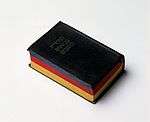
Torah Prophets Writings (The Hebrew Bible), 1978
-
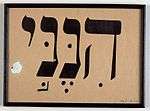
Hinnenni, 1978, Print and acrylic on paper and frame
-
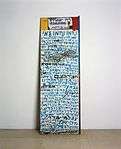
Comfort Ye, Comfort Ye, My People, 1978, Acrylic and oil sticks on wood and street sign
-
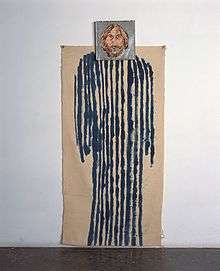
Coat of Many Colors, 1981, Acrylic on canvas, Israel Museum Collection
-

The Wandering Jew, 1983, Acrylic and pencil on canvas
-
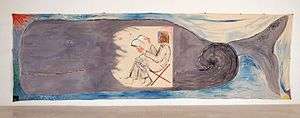
Leviathan, 1983, Acrylic on canvas, Israel Museum Collection
-
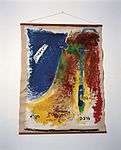
Symbolic Map, 1983, Acrylic on canvas
-
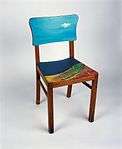
Sitting/Settlement, 1992, Acrylic on wood
-
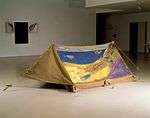
Judea Galilee, 1994, Acrylic and army rangers' tent
-
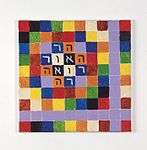
Haor Roeh (The Light Sees), 1998, Acrylic on canvas
Education
- 1965–1969 B.A. History of Art and philosophy, The Hebrew University of Jerusalem
- 1969–1973 M.A. History of Art, University of California, Los Angeles, USA
- 1989 PhD City University of New York City, New-York, USA
Teaching
- 1973–1978 – Brooklyn College, New York City
- 1977–1978 – Bezalel Academy of Arts and Design, Jerusalem
- 1977–1978 – University of Haifa, Haifa
- 1979 – School of Visual Arts, New York City
- 1990–1998 – Art Institute – Oranim Academic College, Kiryat Tivon
- 1990–1998 – Bezalel Academy of Arts and Design, Jerusalem
- 1990–1998 – Kalisher Art Academy, Tel Aviv-Yaffo
Solo exhibitions
- 1978 Hakibbutz Gallery, Tel-Aviv
- 1993 Library Foyar, Tel-Aviv Museum of Art
- 1994 "Michael Sgan-Cohen, Paintings, 1978 – to date", Museum of Israeli Art, Ramat-Gan
- 2004 "Michael Sgan-Cohen, a Retrospective", The Israel Museum, Jerusalem
Two-artist exhibitions
- 1995 "Twice over", Haim Maor and Michael Sgan-Cohen,Bar-David Museum, Bar-Am
- 1996 "Painting a Land", Tzibi Geva and Michael Sgan-Cohen, Julie M. Gallery, Tel-Aviv
- 2008 Idan Erez / Michael Sgan-Cohen, Hamidrasha Gallery, Tel-Aviv
Group exhibitions
- 1981 "Ulam 1", Artists House, Jerusalem
- 1982 Dvir Gallery, Tel-Aviv
- 1982 "Black and White", Public image, New-York
- 1983 Dvir Gallery, Tel-Aviv
- 1983 "Events '83, "Metaphysics", Artist House, Jerusalem
- 1984 "Art and Ego", Pan-Art, New York
- 1985 "Towards Myth Without God", Artists House, Jerusalem
- 1985 "In the Open", National Park, Ramat-Gan, Ramat-Gan
- 1987 "Israeli Art", The Israel Museum, Jerusalem
- 1987 "Vistas-Landscape". Einnstein Gallery, New-York
- 1987 "Second Coming", Dramatis Personae, New York
- 1987 "Drawings", The Eika Gallery, Jerusalem
- 1988 "Criticts Choice". Artifact Gallery, Tel-Aviv
- 1990 "New Acquisitions", The Israel Museum, Jerusalem
- 1991 "Routes of Wandering", The Israel Museum, Jerusalem
- 1991 "Grids", Kalisher Five Art Gallery, Tel-Aviv
- 1991 "Drawing Now, Drawing Here", Kalisher five Art Gallery, Tel-Aviv
- 1992 "Two Dimensions, One Dimention", Israel Festival, Jerusalem
- 1993 "Sham",The Israel Museum, Tel-Aviv
- 1993 "Artists Books", Kalisher Five Gallery, Tel-Aviv
- 1993 "International match box Art Exhabition", The Art Workshop Gallery, Yavneh
- 1994 "Tel-Hai", Tel-Hai
- 1994 "Flags", Omanut La'am
- 1994 "Separate Worlds", Tel Aviv Museum of Art
- 1994 "Anxiety", Ramat-Gan Museum of Israeli Art, Ramat-Gan
- 1994 "Identity, artist, Place", Artists House, Jerusalem
- 1995 "Critic's Choice", Artists House, Tel-Aviv
- 1995 "My heart is in thr East", Center for Contemporary Art, Haifa
- 1995 "Blue White", Bineth Gallery, Tel-Aviv
- 1995 "A Place of Shelter", Municipal Art Gallery, Jerusalem
- 1996 "Windows", The Israel Museum, Jerusalem
- 1996 "Ketav-Flesh and Word in Israeli Art", Ackland Art Museum, University of North Carolina at Chapel Hill
- 1997 "Art and Fate", The New Workshop, Ramat-Eliahu
- 1998 "Where Have We Come From and Where Do We Go"? Yad Labanim Museum of Art, Petach Tikva
- 1998 "Flag-Nationality-Flag", Pyramid Center for Contemporary Art, Haifa
- 1998 "Perspectives on Israeli Art on the Seventies", Tel-Aviv Museum of Art
- 1998 "Kol Anot", Israeli Art and the Bible", Artists House, Tel-Aviv
- 1998 "To the Tmb of the Righeous", The Israel Museum, Jerusalem
- 1998 "To the East- Orientalism in the Arts in Israel", The Israel Museum, Jerusalem
- 1998 "Private Icons", Pyramid, Center for Contemporary Art, Haifa
- 1998 "Artists on the Peace Way", Givataim Theatre, Givataim
- 1998 "Private Icons", Library & Memorial Center, Kriat Tivon
- 1998 "Stains", The Israel Museium, Jerusalem
- 1998 "Ministry od Education and Culture Prize for Artists, in the fields of Plastic Art 1997/1998
- 1998 "Good Kids, Bad Kids', Childreness in Israeli Art, The Israel Museum, Jerusalem
- 1998 "In the Name of the Land. In the Name of the Lord", The Artists House, Jerusalem
- 1999 "Summer Harvest", The Israel Museum, Jerusalem
- 2000 "Art and Artists from Israel and Palestina", Pallazzo della Papesse, Siena, Centro Arte Contemporana
- 2001 "Love at first sight", The Israel Museum, Jerusalem
- 2001 "Israeli Habitat", The Dwek Gallery, Jerusalem
- 2001 "Le Juif Errant, Un Temoin Du Temps, Musee d'art et d'histoire du Judaiisme
- 2001–02 "Hands", The Israel Museum, Jerusalem
- 2002 "Acquisitions from the Uzi Zucker Foundation for Contemporary Israeli Art", Tel-Aviv Museum of Art
- 2002 "Running Words", On the writing of Prints, Jerusalem Print Workshop
- 2003 "Present Tense 2", The Israel Museum, Jerusalem
- 2003 "Self Portrait", Gordon Gallery, Tel-Aviv
- 2003 "The Right of the image – Jewish Perspectives in Modern Art, Museum Buchom, Germany
- 2004 "Dead and", Gordon Gallery, Tel-Aviv
- 2005 "Handwriting", a group exhibition, Gordon Gallery, Tel-Aviv
- 2006 "The Devine Image: Depicting God in Jewish and Israeli Art", The Israel Museum, Jerusalem
- 2007 "Visual Israeliness",The open University of Israel, Raanana
- 2008 "Evantually Wi'll Die ",The Fifth Decade: Art in Israel, 1988–1998, Herzliya Museum of Contemporary Art, Herzliya
- 2008 "Check Post", The Fourth Decade: Art in Israel, 1978–1988, Haifa Museum of Art, Haifa
- 2008 "My Own Body", The Third Decade: Art in Israel, 1968–1978), Tel-Aviv Musem of Art
- 2008 "Typisch! Klischees von Juden und Andern, Judisches Musem, Berlin, Germany
- 2008 "Mr. Guskin", Art T.L.V. Balcony, Nachalat Binyamin, Tel-Aviv
- 2008–09 "Hidden Traces – Jewish Diaspora Ostopography of the Avant-Garde",Felix Nussbaum-Hous, Osnabruck, Germany
- 2008–2009 "Van Gogh in Tel Aviv", Rubin Museum, Tel Aviv, Curators: Carmela Rubin, Edna Arda, Shira Naftali
- 2009 "Watermelons", Rubin Museum, Tel Aviv, Curators: Carmela Rubin, Shira Naftali
- 2009 "Last Edition": paper as raw material in contemporary Israeli art, Ben-Gurion University, Beer-Sheva. Curators: Haim Maor and students from the curating studies
- 2009 "Careful, glued!" Collages from the Museum and other collections, the Tel Aviv Museum of Art, Curator: Irit Hadar
- 2009 "Selection of Israeli Art from the Collection of Gaby and Ami Brown", Museum of Art, Ein Harod
- 2009 Typical Clichés of Jews and Others, Jewish Museum, Vienna
- 2011–2014 "The Museum Presents Itself" from the Museum of Israeli Art, Tel Aviv Museum
- 2011 Auf des Spuren Judicher Zeichen, Kultur Bahnhof Eller, Düsseldorf, Germany, Curator: Avraham Eilat
- 2012 "Portraits of Cain": Representations of 'others' in Contemporary Art in Israel', Ben-Gurion University, Beersheba, Curator: Haim Maor
- 2013 "Image of the Word" active exhibition, the Art Institute Oranim, Kriat Tivon
- 2013 "Now, now" Biennale of Jerusalem, The brothers adherent compound, Jerusalem, Curators: Porat Salomon, Oryan Galster
- 2014 "Revelations" Jerusalem Print Workshop, Jerusalem, Curators: Irena Gordon, Tamar Gispan-Greenberg, Arik Kilemnik
- 2015–2016 "Israeli Art", A New Permanent Exhibition, The Israel Museum, Jerusalem, Curator: Amitai Mendelsohn
- 2016 Alchemy of Words: Abraham Abulafia, Dada, Lettrism, Tel Aviv Museum of Art, Curator: Dr. Batsheva Goldman-Ida
Awards and prizes
- 1994–1999 Artist-in-residence, The Jerusalem Foundation, Jerusalem
- 1998 Ministry of Education and Culture Prize
- 1997 George and Janet Jaffin Prize for Excellence in Plastic Arts, America-Israel Cultural Foundation
- 2001–02, 2002–03 Memorial Foundation for Jewish Culture, New York City
Selected art critic and writings
- Michael Sgan-Cohen, "The Jewish Experience in Art, Art in America, May- June 1976, pp. 44–47
- Michael Sgan-Cohen, "Kiesler on stage and off", Theatre design, Art in America, summer 1981, pp. 37–39
- Michael Sgan-Cohen, "Motti Mizrahi: A New Song", The Venice Biennale, 1988, The Israeli Pavilion
- Michael Sgan-Cohen, "Frederick Kiesler: Artist, Arcitect, Visionery, A study on his work and writing", 1989, PhD, CUNY, New York (A short summery that was compiled by Valentina Sonzogni for the Kiesler Foundation research deparetment in order to add information to the status que of the international research.)
- Michael Sgan-Cohen, "Yaakov Dorchin: East of Eden", Dorchin, The Venice Biennale, 1990, The Israeli Pavilion
- Michael Sgan-Cohen, "Le Sanctuaire du Livre et L'art de transformer le superflu en necssaire", Collection Monographie Frederick Kiesler sous la direction de Chantai Béret, Edition du Centre Georges Pompidou, 1996, pp. 229–239
- Michael Sgan-Cohen, "Ketav and Hebrew in Israeli Art" Flesh and Word in Israeli Art, Ackland Art Museum, The University of North Carolina at Chapel Hill, (Catalogue) pp. 41–51
Selected Hebrew writings
- "Cain, artist, Wandering Jew", Proza, No. 43, Dec. 1980, pp. 28–30 (Hebrew)
- "Assumptions Concerning the possibility of the Birth of Jewish-Israeli Art", Jerusalem, Vol. 11–12, Bezalel, Feb. 1984, pp. 79–87 (Hebrew)
- "Between New York and Jerusalem" Kav, June 1984, pp. 64–76 (Hebrew)
- "Tzeva" (color), Bezalel No.1, Feb. 1984, pp. 67–73 (Hebrew)
- "A Cautious Touch of Sources", Studio, No.14, Sept. 1990, p. 32 (Hebrew)
- "Hur and Aharon – An Autointerview on Art, Religion and Israeliness", Studio, No. 17, Dec. 1990 (Hebrew)
- "From the Horse Mouth", Studio, No. 52, April 1994, pp. 15–19 (Hebrew)
Further reading
- Doreet Levitte-Harten, "Protest und Mitleid in der zeitgenossischen", Nike 19, Juli–Sep. 1987, pp. 8–9
- Gideon Ofrat, "Flesh and Word in Israeli Art", Ackland Art Museum, The University of North Carolina at Chapel Hill, Curator: Gideon Ofrat (Catalogue)
- Gideon Ofrat, “One Hundred Years of Art in Israel”, Westview Press, a division of Harper Collins Publication, 1998, pp. 326–327
- Arturo Schwarz, "Towards the Sublime / Michael Sgan-Cohen", Love at First Sight, Israel Museum, Jerusalem, pp. 34–37, 2000
- Milly Heyd, Selbstportrats: Zor Frage da Judischen Identitat, Das Rech des Bilds, "Jusische Perspektiven in der Modernnen Kunst", Herausgegeben von Hans Gunter Golinski und Sepp Hiokisch Picard, 2003, pp. 86–120
- Ayelet Kohn, ”Haaretz”, Michael Sgan-Cohen, Journal of Visual Literacy, Vol. 24 Number 1, Spring 2004
- Judith Margolis, "Resident Artist: Spiritual Androgyny in the Art of Michael Sgan-Cohen and Carole Berman", Nashim: A Journal of Jewish Women's Studies & Gender Issues No. 10, Jewish Women's Spirituality (2) Published by: Indiana University Press (Fall, 5766/2005), pp. 225–242,
- Yael Guilat, Between Painting and Poetry, Sacred and Secular Realms: Yehudah Amichai and Michael Sgan–Cohen, Pictorial Languages and their Meanings, Liber Amicorum in Honor of Nurith Kenaan-Kedar, Edited by Christ Christine B. Verzar and Gil Fishof, Tel-Aviv University, The Yolanda and David Katz Faculty of the Arts, 2006, pp. 295–304
- Emma Azriel Gashinski, "A Split Identity – The Uncanny in Michael Sgan-Cohen’s Art", The Protocols of Bezalel's Young, Issue No. 9 ,July 2008
- Shulamit Laderman,"The unique significance of the Hebrew Alphabet in the works of Mordecai Ardon and Michael Sgan-Cohen", Arts Judaica, The Bar-Ilan Journal of Jewish Art, Volume 5, 2009, pp. 85–107
- David Heyd, ”Between Response and Responsiveness: On Michael Sgan-Cohen's Hinneni", Jewish Dimensions in Modern Visual Culture, eds. Matthew Baigell, Milly Heyd, Rose-Carol Washton Long, Brandeis Press (8 December 2009), pp. 273–285
- Milly Heyd, "Word and Image: The Leviathan in Michael Sgan-Cohen’s' Art", Jewish Dimensions in Modern Visual Culture, eds. Rose Carol, Washton Long, Matthew Baigell and Milly Heyd, Brandeis Press (December 8, 2009), pp. 193–219
References
- ↑ "Michael Sgan-Cohen". Information Center for Israeli Art. The Israel Museum.
- ↑ Michael Sgan-Cohen : A Retrospective. 9 November 2004 – 21 May 2005. The Israel Museum.
External links
- "Michael Sgan-Cohen". Information Center for Israeli Art. The Israel Museum
- Michael Sgan-Cohen: A Retrospective. 9 November 2004 – 21 May 2005. The Israel Museum
- "Michael Sgan-Cohen" at the Israel Museum Collection
- "Michael Sgan-Cohen" The Bezalel Narkiss Index of Jewish Art, The Center for Jewish Art, The Hebrew University of Jerusalem